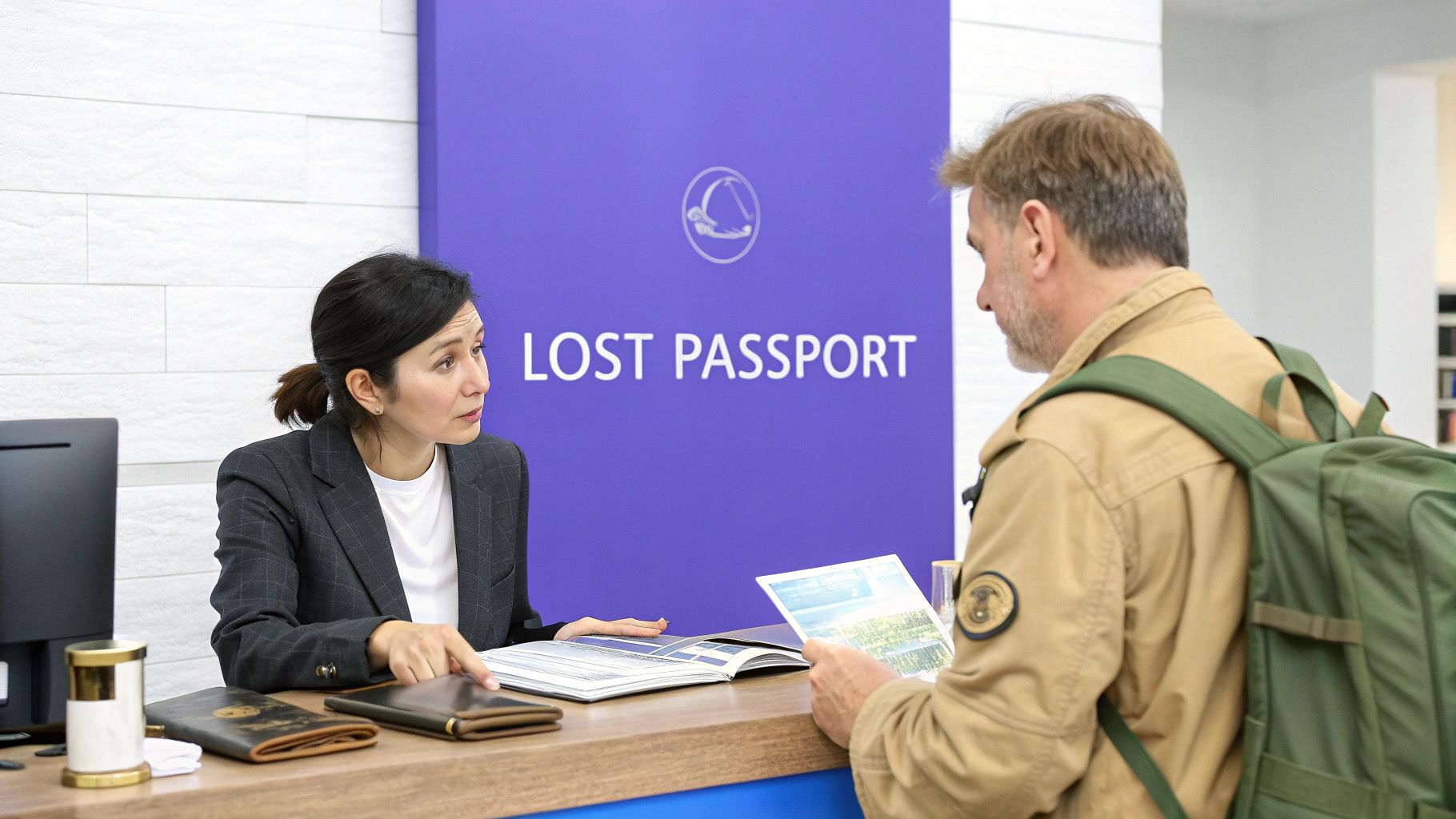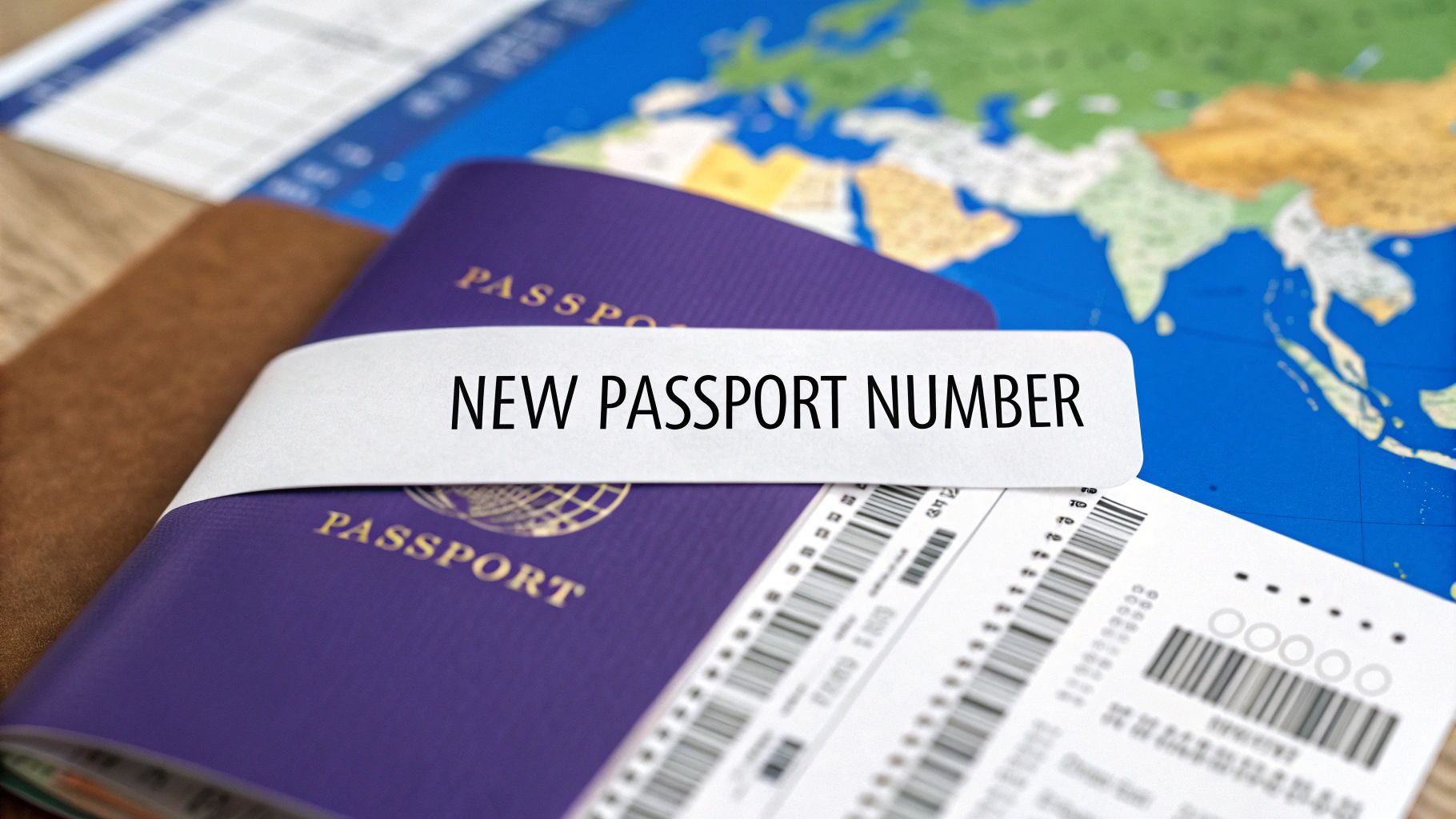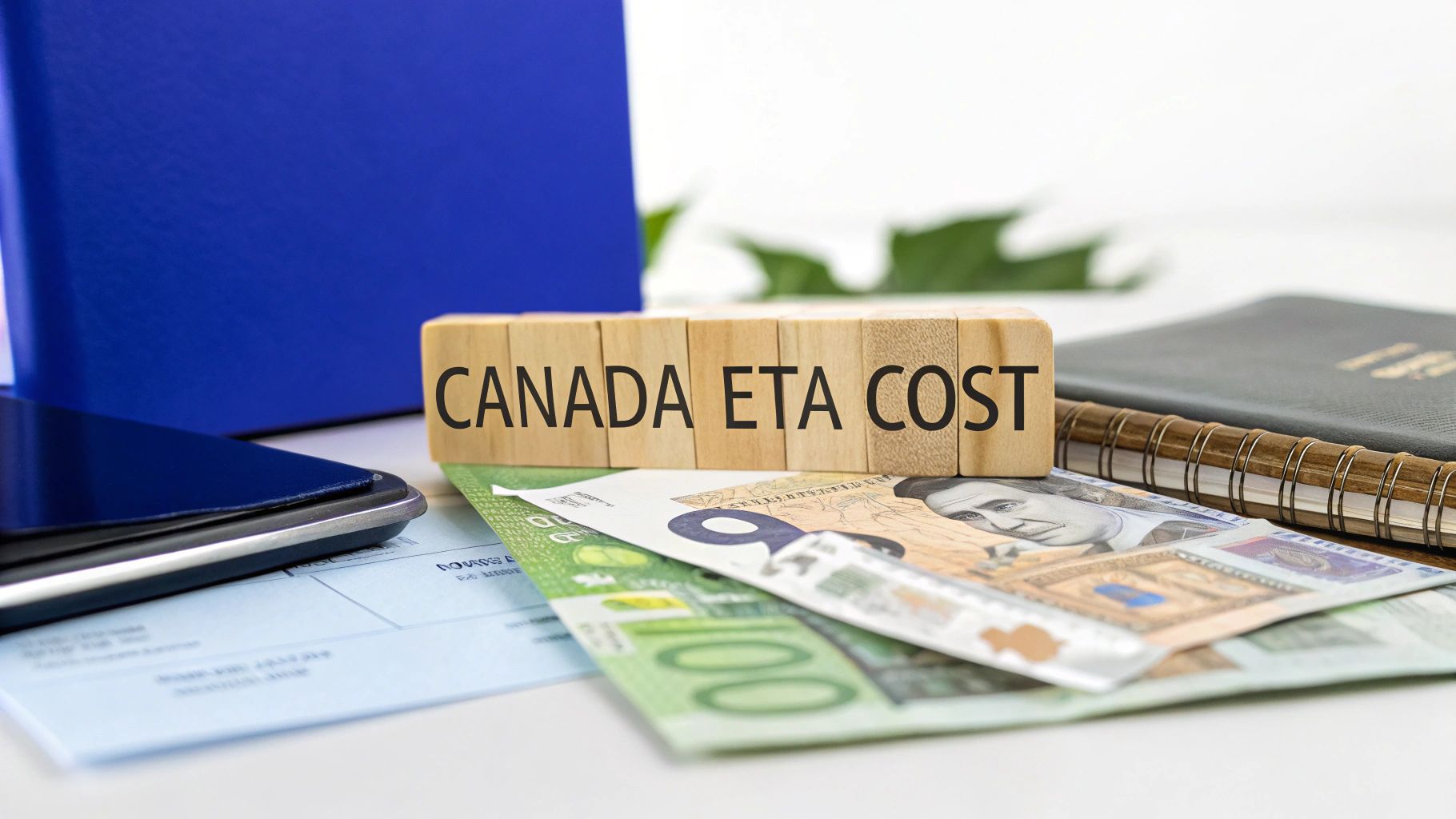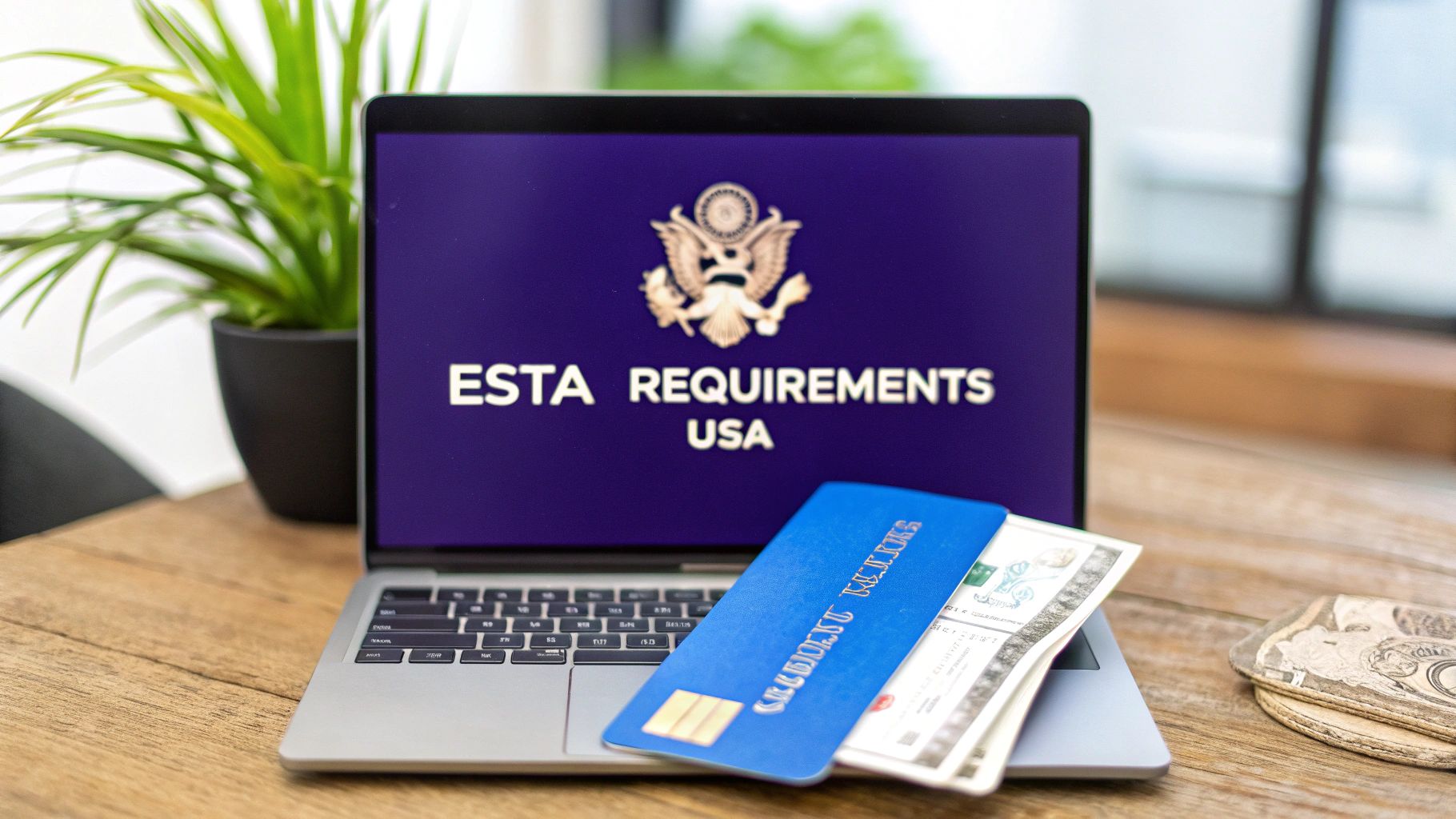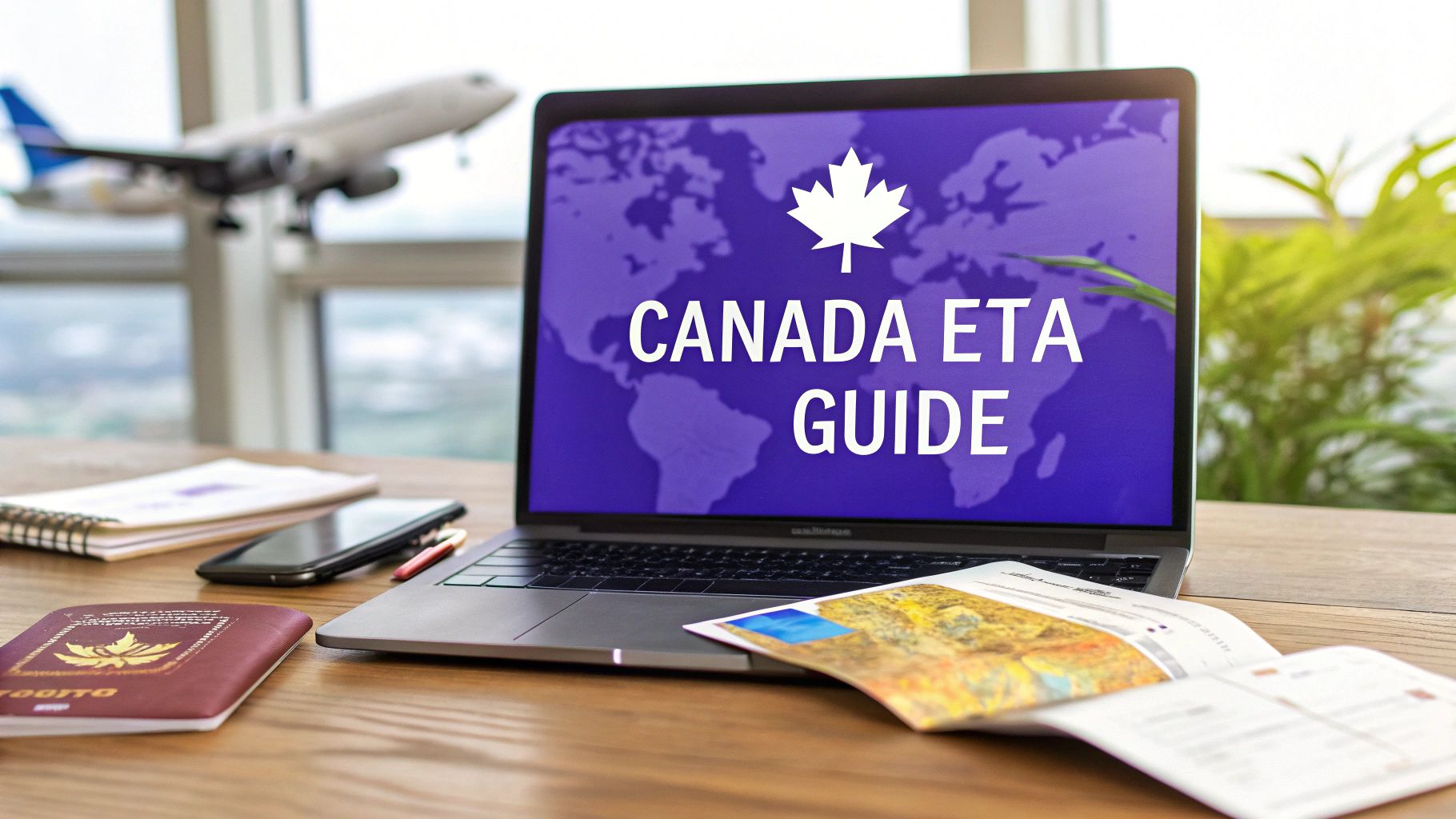
Travel to UK Visa Requirements: Essential Guide for Your Visit
One of the first questions on every traveler's mind is, "Do I actually need a visa to visit the UK?" The truth is, there's no simple yes or no. The answer really hinges on three things: your passport, your reason for visiting, and how long you plan to be there.
For the most part, travelers fit into one of two main buckets: visa-exempt nationals, who can pop over for short trips without a formal visa, and visa-required nationals, who must secure a Standard Visitor Visa before they even think about packing.
Navigating Your UK Entry Requirements
Figuring out whether you need a visa or the UK’s new Electronic Travel Authorisation (ETA) is your first real step in planning. Think of it like a priority lane system for entering the country.
For years, people from certain countries could enjoy visa-free travel for a quick holiday or a short business meeting. That's all changing. The UK is rolling out its UK ETA scheme, which is basically a mandatory digital pre-clearance for many of those same visa-exempt travelers.
Let's be clear: an ETA is not a visa. It's a much lighter, faster online process that confirms you're good to go, making your arrival at the border a lot smoother. A Standard Visitor Visa, on the other hand, is a more in-depth application for longer stays, specific activities, or for anyone from a non-visa-exempt country.
Visa-Exempt vs. Visa-Required Travelers
Getting this distinction right is key.
- Visa-Exempt Travelers: If you hold a passport from a country like the USA, Canada, Australia, or an EU nation, you generally don't need a visa for visits up to six months. However, you will now need to apply for a UK ETA before your trip.
- Visa-Required Travelers: If you're a citizen of many other nations, you’ll need to secure a Standard Visitor Visa no matter how short or simple your trip is. This is a more involved process requiring biometric data (fingerprints and a photo) and proof that you can support yourself financially.
Just to give you a sense of scale, the UK issued around 2.2 million visitor visas in the year ending March 2025. That number alone shows just how many people fall into the visa-required category and highlights the UK's massive draw as a global hub. You can dig into the official numbers in the UK government's immigration statistics report.
This simple decision tree helps visualize how your purpose of travel points to the correct visa type.
As you can see, what you plan to do in the UK—whether it’s tourism, study, or work—directly determines the specific immigration path you need to follow.
To help you quickly figure out where you stand, here’s a straightforward comparison between the Standard Visitor Visa and the new UK ETA.
UK Entry Requirements At a Glance: Visa vs ETA
This quick-reference table should help you see whether a visa or an ETA is more likely for your situation.
| Requirement Type | Who Typically Needs It? | Purpose of Travel | Application Process |
|---|---|---|---|
| UK ETA | Citizens of visa-exempt countries (e.g., USA, EU, Canada, Australia). | Tourism, visiting family, short business meetings, or transiting through the UK. | A quick online application, often with a decision in minutes to a few days. |
| Standard Visitor Visa | Citizens of visa-required countries or anyone staying over 6 months. | Longer-term tourism, specific business activities, short-term study, or private medical treatment. | A detailed application with biometrics, supporting documents, and longer processing times. |
Hopefully, that clears things up! Knowing which category you fall into from the start saves a lot of headaches down the road and ensures your UK travel plans get off to a smooth start.
Getting to Grips with the New UK ETA System
The way the UK manages its borders is undergoing a major shift, and at the heart of it is the Electronic Travel Authorisation (ETA). The best way to think about it is as a digital green light for travellers who previously didn't need a visa to visit. This isn't about making things harder; it's about beefing up border security and making the arrival process much smoother for millions of people every year.
Essentially, the UK ETA is a pre-screening tool. It lets UK authorities get a heads-up on who is planning to travel before they even get to the airport. This isn't a visa, but rather digital permission to board your plane. By screening visitors in advance, the system can flag potential security concerns and stop individuals who might not meet immigration rules from travelling in the first place. For you, the traveller, this translates to a faster, less stressful experience at the border, often whisking you through automated e-gates.

The goal is to make the process as clear and simple as possible, guiding you through each question so you can provide all the right details from the start.
So, Who Actually Needs a UK ETA?
This new system directly impacts people from countries that have long enjoyed visa-free travel to the UK. This includes citizens from places like the United States, Canada, Australia, and every country in the European Union. If that's you, and you're planning a short trip for one of the reasons below, getting an approved ETA is now a mandatory step before you can even check in for your flight.
- Tourism: Whether you're sightseeing in London, hiking in the Scottish Highlands, or exploring ancient castles.
- Visiting Family or Friends: Popping over to see loved ones who live in the UK.
- Short-Term Business: Attending a conference, negotiating a deal, or taking part in business meetings.
- Transit: Just passing through a UK airport on your way somewhere else? You'll still need one, even if you don't officially cross the border.
It's worth noting that British and Irish citizens are exempt and don't need an ETA. For nearly everyone else who used to just book a flight and go, this is a significant new travel requirement to factor into your plans.
Good to Know: An approved ETA is good for two years and covers multiple entries into the UK. Each visit can last up to six months, making it a very practical travel authorization for UK trips over that period.
Why Getting Your Application Right the First Time Is So Important
The ETA application might seem more straightforward than a full visa application, but it’s unforgiving when it comes to mistakes. Even tiny errors—a typo in your name, mixing up a digit in your passport number, or forgetting a detail in your travel history—can cause delays or an outright rejection. A denied ETA can throw a real wrench in your plans, potentially forcing you onto the much longer and more complicated path of applying for a Standard Visitor Visa.
This is where getting a bit of expert help can be a game-changer. Honestly, navigating the official travel to UK visa requirements can be a headache, and making sure every single detail is perfect is the key to getting a quick approval.
To simplify your ETA application and increase your chances of approval, consider using AssistEntry — their experts guide you through the entire process, starting from just $79. As a third-party application assistance provider, their team reviews every field of your application, checking for errors, omissions, and compliance issues before it's sent off. This careful verification dramatically boosts your chances of a first-time approval and helps you sidestep any stressful, last-minute travel disasters.
When You Need a Standard Visitor Visa Instead
While the new UK ETA is a game-changer for short trips, it doesn't cover every situation. Sometimes, you'll need to go the traditional route and apply for a Standard Visitor Visa. Knowing when to make that switch is essential to avoid any trouble with UK immigration.
Think of the ETA as an express pass for simple, short-term visits. But if your plans are more involved, you’ll need a more comprehensive form of permission. That’s where the Standard Visitor Visa comes in—it’s designed for situations that go beyond the basic scope of visa-free travel.
Key Scenarios Requiring a Standard Visitor Visa
You absolutely must apply for a Standard Visitor Visa instead of an ETA if your trip falls into certain categories. Getting this wrong could mean being turned away at the border, so it's critical to know which rules apply to you.
You'll need a visa if you are:
- A Citizen of a Visa-Required Nation: If your passport is from a country that isn't on the UK's visa-exemption list, you need a Standard Visitor Visa. It doesn’t matter how short your stay is.
- Planning a Longer Stay: The ETA is strictly for visits of up to six months. If you want to stay in the UK for longer than that, a visa is mandatory.
- Undertaking Specific Activities: If you plan to do things not allowed under the visitor rules—like paid work, formal study, or getting married—you need a specific visa for that purpose.
Key Takeaway: The Standard Visitor Visa becomes necessary when your nationality, the length of your trip, or your planned activities fall outside the strict limits of the visa-waiver program and the new ETA system.
Exploring Valid Reasons for a Visitor Visa
The Standard Visitor Visa is surprisingly flexible. While most people think of it for tourism, it actually covers a wide range of activities, which shows how diverse travel to UK visa requirements can be.
Here are some common reasons people apply:
- Tourism and Leisure: Perfect for holidays, especially if you’re planning a longer trip that pushes close to the six-month mark.
- Business Activities: You can attend conferences, negotiate deals, or conduct site visits. What you can’t do is paid work for a UK company.
- Private Medical Treatment: This allows you to receive care at a UK hospital or clinic.
- Short-Term Study: You can take a recreational course for up to 30 days (like a weekend cooking class) or even a short study program at an accredited school for up to six months.
The numbers behind visa applications tell a story. For example, recent data from March 2025 showed that changes to the income requirements for family visas caused applications to jump and then fall dramatically. It’s a perfect illustration of how sensitive travel plans are to government policy. You can see these trends for yourself in the government's latest statistical report.
For travelers from visa-exempt countries like the US, the line between needing an ETA and a visa can feel a bit blurry. For a closer look at the rules specifically for American travelers, check out our guide on the UK ETA for US citizens.
How to Apply for Your UK ETA the Easy Way
Alright, so you've figured out you need an Electronic Travel Authorisation for your trip to the UK. Now what? The next step is the application itself, and while it’s all done online, it can feel surprisingly high-stakes.
Think about it: one tiny mistake—a single transposed digit in your passport number or a forgotten detail in your travel history—could cause a delay or even an outright rejection. That’s a massive headache you just don’t need when you’re planning a trip.
The goal isn't just to fill out a form; it's to submit a perfect one that glides through the system without any red flags. For a lot of people, the smartest way to guarantee that is by using a specialized service that acts as a second pair of eyes.
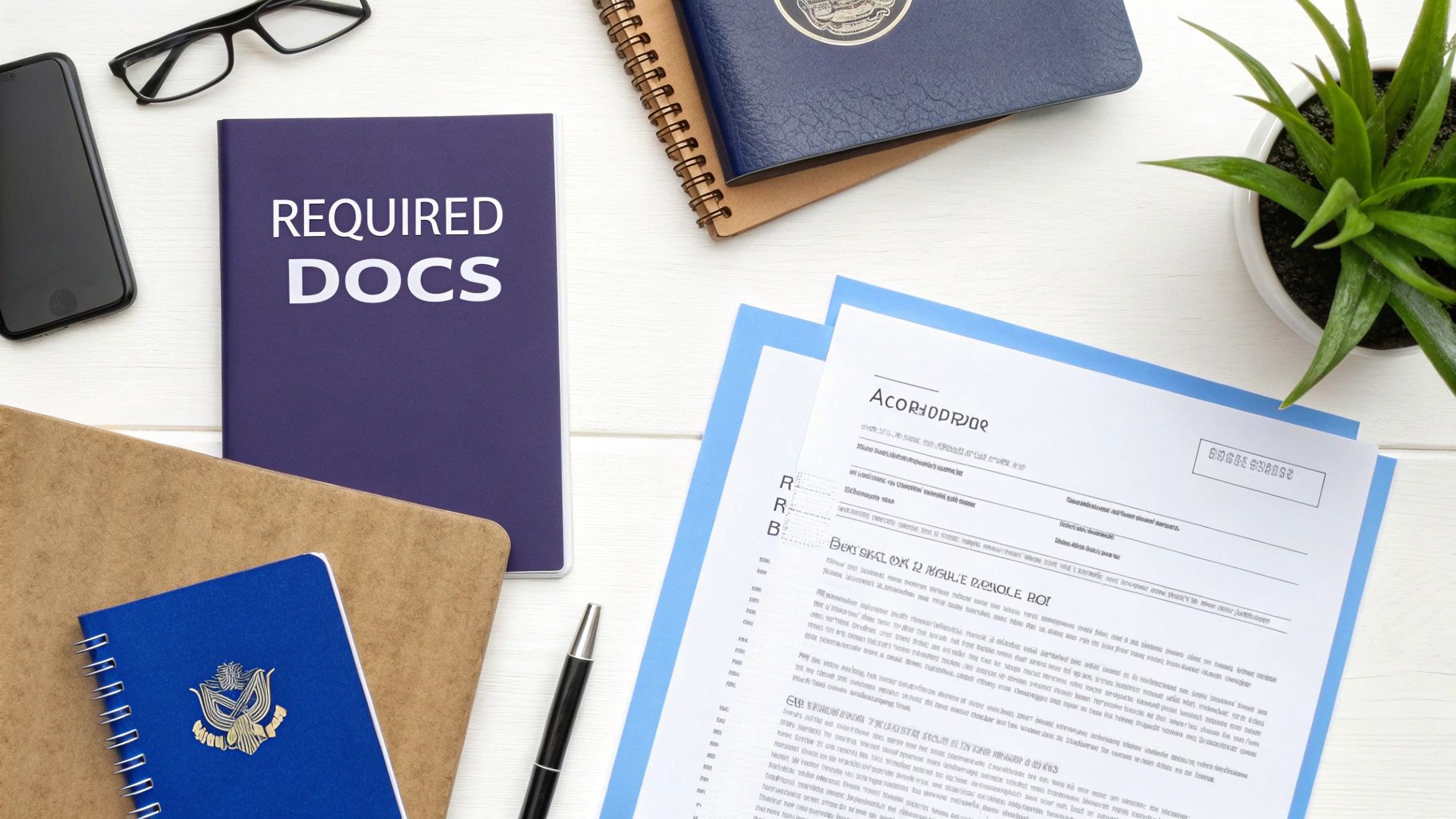
A Simplified Path to Your UK ETA
Let's be honest, government websites can be clunky and confusing. But applying for your UK ETA doesn't have to be a stressful ordeal. Using a trusted third-party application assistance provider like AssistEntry turns a potentially tricky process into a straightforward, guided experience, giving you total confidence.
Here’s a simple roadmap to getting your UK ETA approved with an expert in your corner:
Start in the Right Place: Go straight to AssistEntry’s UK ETA application page. It's a purpose-built portal designed to be clear and simple, cutting out the guesswork you might face elsewhere.
Fill Out the Easy Form: The form is intuitively laid out with helpful prompts. It's designed to make sure you provide exactly the information needed, without any of the confusing official jargon.
Upload Your Documents Securely: You can safely upload your passport copy and any other necessary documents. The platform uses strong security to protect your personal data.
Get an Expert Review: This is where the real magic happens. After you submit, the AssistEntry team does a full verification of your application. Their experts meticulously check every detail for accuracy and common errors before it goes to the UK authorities.
Receive Your Approved ETA: Once it's reviewed and submitted, your approved Electronic Travel Authorisation is sent right to your email. No need to keep refreshing a government portal, wondering about the status.
This isn’t just about filling in boxes on a screen. It’s about getting peace of mind and dramatically increasing your odds of a first-time approval.
The Value of Professional Application Assistance
You might be thinking, "Can't I just do this myself?" Of course you can. But it’s worth knowing what you get with a professional service. The official application process is automated and unforgiving—a simple typo can trigger an automatic "no."
Key Insight: Using an expert service is like having a friend who knows the immigration system inside and out double-check your work. They have the experience to spot potential issues that an automated system would flag, but that you might easily miss.
For a fee that starts from $79 (it include government fee, all cost included), AssistEntry provides a service built to catch these problems before they happen. This all-in-one price gets you:
- Full Application Verification: An expert reviews your entire application to make sure every field is filled out correctly and completely.
- Error-checking and Compliance: They hunt for common mistakes like typos, incorrect date formats, and inconsistencies that can cause an instant rejection.
- Increased chances of approval due to expert handling, helping you avoid costly mistakes and potential delays.
This approach saves you time and protects you from the stress of a potential denial. If you want to dig deeper into the specifics, check out our guide on the UK ETA application process.
Ultimately, the choice is yours. But for many travelers, that small investment is well worth the assurance that their travel authorization for UK entry is handled correctly from the start. To simplify your application and boost your chances of approval, consider letting the experts at AssistEntry guide you.
Common Application Mistakes and How to Avoid Them
It’s a scenario that plays out all too often: a tiny, overlooked typo on a UK ETA application spirals into a massive travel headache. The official system is automated and unforgiving, meaning there's no room for simple human error. One wrong digit or a misunderstood question can trigger a frustrating delay or an outright rejection, throwing your entire trip into jeopardy.
The first step to a smooth journey is knowing what those common pitfalls are. Many travelers get tripped up on what feel like minor details, but these are exactly the kinds of predictable errors the system is designed to flag. Being aware of them beforehand gives you a huge advantage.
Frequent and Costly Errors
Let's talk about the mistakes that come up time and time again.
One of the biggest culprits is a passport details mismatch. Your name, date of birth, and passport number must be entered exactly as they appear on your passport's information page. A single incorrect letter or a swapped number is enough for the automated system to reject your application on the spot.
Another common stumbling block is an incomplete or inaccurate travel history. The form will likely ask about your previous trips to the UK and other countries. If you forget to mention a past visit or get the dates wrong, it can be flagged as a discrepancy, raising doubts about your application.
Finally, people often get tangled up in the questions about criminal convictions. It’s absolutely critical to be honest here, even if it's for a minor issue from a long time ago. A background check that turns up something you didn't disclose is a serious red flag and almost guarantees a refusal.
Expert Insight: Think of it this way: the UK's ETA system is constantly cross-referencing your application data against huge international security databases. An inconsistency isn't just seen as a mistake; it's a potential security alert that can bring your application to an immediate halt.
The Smart Way to Avoid Application Headaches
This is where getting a second set of expert eyes on your application becomes invaluable. The pressure to get every single detail perfect on your UK ETA application can easily overshadow the excitement of planning your trip. Why risk it?
Using a third-party application assistance provider like AssistEntry is a smart investment in your own peace of mind. Their whole system is built to catch the very mistakes that cause most rejections.
- Verification Before Submission: Their experts give your application a full review, checking everything for accuracy and compliance before it ever goes to the government.
- Catching Costly Errors: They are trained to spot those easy-to-miss passport mismatches, incomplete histories, and other common blunders.
- Guidance on Tricky Questions: They help you navigate ambiguous questions, making sure your answers are both truthful and correctly formatted.
This professional check dramatically boosts your chances of a first-time approval. With prices starting from $79 (it include government fee, all cost included), you're not just filling out a form—you're buying a stress-free start to your UK adventure. To sidestep the anxiety of a potential rejection and unnecessary delays, consider using AssistEntry. Their experts will guide you through the process, ensuring your application is flawless from the start.
What to Expect When You Arrive in the UK

So, your UK ETA or visa is approved and your bags are practically packed. Fantastic news! But your journey doesn't end the moment your flight touches down on UK soil. The final step is navigating the border, and a little preparation here can make a world of difference.
Knowing what to expect at UK Border Control can transform a potentially stressful experience into a smooth, hassle-free start to your trip. Even though your approved travel permit is digitally tied to your passport, having a few key documents within easy reach will help you breeze through the process.
Your Essential Arrival Checklist
Before you even think about joining the queue for immigration, it’s smart to have your documents organised and ready to go. Think of it as your passport to a quick entry.
- Your Valid Passport: This is the big one. It must be the same passport you used when you applied for your UK ETA or visa. No exceptions.
- Proof of Your Authorisation: While an ETA is digital, having a printed copy of the approval email or a clear screenshot on your phone is always a good backup. If you have a visa, it will be a physical sticker (vignette) inside your passport.
- Accommodation Details: Be ready to show the address and contact details for your hotel, holiday rental, or the friend you're staying with.
- Return or Onward Flight Information: Border officers want to be sure you plan on leaving the UK. Having your flight confirmation handy demonstrates this perfectly.
This level of readiness is more important than ever. The UK remains a top global destination, with VisitBritain forecasting a staggering 43.4 million visits in 2025. With that many people passing through, being prepared helps everyone. For more details on this trend, you can check out the UK tourism forecasts and insights on VisitBritain.org.
Navigating Immigration and Customs
After you get off the plane, you'll follow the signs to immigration control. Here, you'll either be directed to an automated e-gate or to a queue to speak with a Border Force officer. The e-gates are becoming more common; they use facial recognition to match you with the data in your chipped passport and your digital ETA, making for a swift entry.
If you're guided to an officer, don't worry. They’ll likely ask a few simple questions about your trip—why you're visiting, how long you're staying. It’s a routine check to confirm your plans align with your travel authorisation. Just answer their questions clearly and honestly. For a deeper dive into this part of the process, have a look at our guide on what to expect at the border when arriving with a UK ETA.
Once you’ve cleared immigration, you'll grab your bags and head through customs. Make sure you're familiar with the UK's customs allowances and declare any required goods. Getting this right ensures your trip starts on a positive note, without any unexpected fines or delays.
Got Questions About Your UK Trip? We've Got Answers.
It's completely normal to have questions when you're figuring out the rules for visiting the UK. To make things easier, we’ve put together some straightforward answers to the most common queries we hear from travelers.
How Long Can I Use My UK ETA For?
This is one of the best parts about the new system. Once your Electronic Travel Authorisation for UK is approved, it’s good for a full two years from the day it's issued. The only catch is if your passport expires before then—the ETA is tied to your passport, so it would expire at the same time.
This two-year validity means you can pop over to the UK multiple times without any extra paperwork. Each visit can last up to six months, which is great for regular tourists, business professionals, or anyone with family in the UK. You won't need to fill out a new UK ETA application every time you plan a short trip during that two-year period.
Can I Work in the UK on a Visitor Visa or an ETA?
This is a really important one to get right. Neither a UK ETA nor a Standard Visitor Visa allows you to take a job in the UK. The UK government is incredibly strict about this, and working illegally can have serious repercussions, like being barred from entering the country in the future.
That said, you can engage in certain business activities. Think of it this way: you can't be employed by a UK company, but you can do business with one. Permitted activities usually include things like:
- Attending meetings, conferences, and seminars.
- Negotiating and signing contracts.
- Carrying out site visits and inspections.
The crucial difference is that you can't be paid from a UK source for work you do while you're there. Your professional activities must be linked to your job back home.
Key Takeaway: Be upfront about why you're visiting. If the main reason is to do paid work for a UK employer, you'll need a proper work visa, not a visitor permit.
What if My UK ETA Application Is Rejected?
Getting a denial on your UK ETA application can be worrying, but it's not the end of the road for your travel plans. It simply means you can't use the automated, visa-waiver ETA program to enter the UK.
So, what’s next? Your next move is usually to apply for a Standard Visitor Visa. This process is more in-depth and gives you the chance to provide an immigration officer with more context and supporting documents. An ETA denial doesn't count against you when you apply for a visa; it just means your situation needs a closer look than the ETA system can offer.
Sorting through travel to uk visa requirements can feel like a maze, but you don't have to navigate it on your own. For a simple and mistake-free process, let the team at AssistEntry guide you. They check every part of your application to give you the best shot at approval, with services starting at just $79, which includes all government fees. To get your journey started on the right foot, consider applying on AssistEntry’s UK ETA page.
